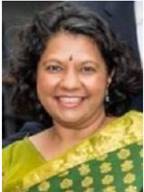By Dr Padma Garvey, MD Hudson Valley, NY
e-mail:Â pgarveymd@gmail.com
Editor: Padma was born in Nellore India and grew up in Pittsburgh. She earned her medical degree from the  University of Pittsburgh in 1992. She is a full-time gynecologist in the Hudson Valley area, married to her physician-husband for 25 years. She has two kids in college. She practices yoga and is dedicated to teaching people about the benefits of a plant-based diet. She has a website (www.drpadmagarvey.com).
University of Pittsburgh in 1992. She is a full-time gynecologist in the Hudson Valley area, married to her physician-husband for 25 years. She has two kids in college. She practices yoga and is dedicated to teaching people about the benefits of a plant-based diet. She has a website (www.drpadmagarvey.com).
Asian Indians have some of the highest rates of coronary artery disease and diabetes in the world. I know from personal experience that many Indians are lulled into a false sense of security because they tend to be vegetarians. My own father, the late Dr. K N Rao, had diabetes. Eventually, he needed bypass surgery, but this extended his life by only two years. In addition, those two extra years of life were spent confined to a bed. Though my father had always been a strict vegetarian, he ate a high fat diet. Dinners included chutneys, ghee on lentils, fried papadam, fried pooris, tamarind rice with lots of oil and white rice, fried samosas, sugary laddoos, sugary jilebis, and yogurt. In addition, the typical Western snacks crept into his life. He ate potato chips, ice cream, candy, and cakes.
There is lot of misinformation about what a healthy diet includes. We hear fat is bad, fat is good. We hear that carbs are the enemy. We hear that protein-centered diets like the keto diet or paleo diet are bad for us.
In actuality, the evidence regarding a healthy diet has been known since the 1930s when Dr. Ancel Keys conducted the famous Seven Country Study. Keys found that countries that consumed low fat diets had better health than countries that consumed high fat diets. In particular, Keys found that the Okinawan and Mediterranean diets in 1930 were extremely healthy having 10-18% total fat.
I came across an interesting study published in the prestigious medical journal The Lancet in 1959, entitled “Serum Cholesterol, Diet, And Coronary Heart Disease in Africans and Asians in Uganda†by Shaper et al. At the time of the publication of this study, coronary heart disease (CAD) was nonexistent among African Ugandans. This alone is a shocking statement since CAD is the Number One killer of African Americans today. While CAD was nonexistent in the African community, it accounted for 43% of all deaths over the age of 30 among Asian Indians in Uganda at that time.
The authors examined the diets of the two communities. The African Ugandans ate a diet which included green leafy vegetables, maize, millet, yams, and beans. They ate very little meat and absolutely no dairy. They did not utilize much cooking oil in their cooking and consumed whole grains. In contrast, the Asian Indians in Uganda in 1959 were consuming white rice, lentils, butter/ghee, yogurt, milk, and lots of cooking oil. The total fat calories in the African Ugandan diet was about 18%. The fat calories in the Asian Indian diet in Uganda was 35-40%.
The typical middle-class, vegetarian Indian diet is even worse today. In general, vegetarian Indians are consuming more refined grains, added sugars, oils, animal dairy, and even cheese. A low-fat, whole grain, plant-based diet has been the only diet ever shown to reverse heart disease. This study conducted by Dr. Dean Ornish was published in the Lancet in 1990. When it first appeared in The Lancet, the results were so startling that many in the medical community felt that it would revolutionize the way CAD was approached and treated. Dr. Dean Ornish even made it on the cover of Time Magazine with the subtitle asking if this was the end of heart disease.
Unfortunately, the fact that Ornish published his ground-breaking research in the British journal, The Lancet, suggests that the American journals passed on it. Around the 1960s, most American medical journals, American medical societies, and even American medical school education were supported by the pharmaceutical industry.
President Bill Clinton suffered a heart attack shortly after he left office. He had bypass surgery. After his surgery, he was on the standard regimen of medications including cholesterol-lowering drugs and told to follow the American Heart Association (AHA) diet. Interestingly, though the Ornish diet was the only diet ever shown to reverse plaques, the AHA recommends the less effective DASH diet. Clinton was quite frightened after his heart attack and followed his cardiologist’s recommendations.
About 18 months later, President Clinton had a re-occlusion or buildup of plaque in his heart. He underwent angioplasty. I remember watching reporters questioning Clinton’s cardiologist at the time. The reporters wanted to know why Clinton had a recurrence of his heart disease despite following the AHA guidelines. The cardiologist said, there was nothing more that could be done about it and that Clinton had bad genes.
Clinton was not satisfied with this response and talks openly about seeking other treatment options. Clinton came across the Ornish study and went to Dean Ornish for guidance. Clinton became a strict low-fat vegan. His daughter, Chelsea, is also one. Since following the Ornish diet, Clinton has been heart disease-free. The past president of the American College of Cardiologists, Dr. Kim Williams from Rush Medical Center says that there are only two kinds of cardiologists, vegans and ones who are unaware of the data.
Indian physicians must be made aware of the proven benefits of a low-fat, whole grain, plant-based diet. We need to educate the Indian community as well as all our patients to avoid needlessly painful, early, and costly deaths. Excellent resources for more information are on the Physicians Committee for Responsible Medicine (PCRM) website.
♠
